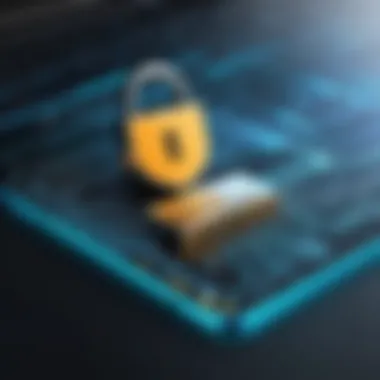Unlocking the Art of Mastering Remote Computer Access: An In-Depth Guide


Introduction to Enhancing Remote Access Security
The landscape of cybersecurity is ever-evolving, and the convergence of network security has become paramount in today's interconnected digital realm. Understanding the significance of cybersecurity in safeguarding remote access into another computer is crucial for individuals and organizations alike. As technology advances, so do the risks associated with cyber threats, making it essential to stay informed and vigilant.
Implementing Robust Security Measures
When it comes to securing remote access, focusing on people, devices, and data is key to maintaining a strong defense against potential vulnerabilities. Implementing robust security measures ensures that personal devices, networks, and sensitive information are adequately protected. By staying proactive and implementing comprehensive security protocols, individuals can mitigate risks and enhance their overall cybersecurity posture.
Navigating Emerging Security Technologies
In the realm of cybersecurity, staying abreast of the latest trends and technologies is essential for effectively combating emerging cyber threats. From artificial intelligence (AI) to Internet of Things (Io T) devices and cloud security solutions, understanding the implications of these advancements is crucial for bolstering network security and protecting sensitive data. Analyzing the impact of cybersecurity innovations provides valuable insights for individuals seeking to enhance their remote access capabilities.
Mitigating Data Breaches and Cyber Risks
Data breaches pose a significant threat to digital security, leading to severe implications for individuals and organizations. By examining recent case studies and understanding the root causes of such breaches, individuals can better prepare themselves to identify and mitigate cybersecurity risks. Implementing best practices and proactive risk management strategies is essential in safeguarding against potential data breaches and cyber threats.
Shaping the Future of Cybersecurity
As the digital landscape continues to evolve, predictions for the future of cybersecurity are crucial for preparing individuals and organizations for upcoming challenges and opportunities. Innovations and advancements in digital security technology play a pivotal role in shaping the future of cybersecurity, offering new possibilities for enhancing remote access security and overall data protection. By staying informed and adaptive, individuals can navigate the dynamic cybersecurity landscape with resilience and foresight.
Introduction to Remote Access
Remote access, a crucial aspect in the realm of technology, plays a pivotal role in facilitating seamless connections and operations between various computers from remote locations. This section serves as a foundational cornerstone in the comprehensive guide to mastering remote access into another computer. Understanding the nuances of remote access is essential for individuals venturing into the technological landscape, providing them with insights into its significance and practical implications. By grasping the fundamentals of remote access, readers will acquire the groundwork necessary to navigate the subsequent sections with adeptness and precision.
Understanding Remote Access
The concept of remote access
Remote access, in its essence, pertains to the capability of gaining entry to a computer system or network from a distant location. This concept revolutionizes the traditional boundaries of computing, enabling users to interact with systems beyond physical reach. The intrinsic feature of remote access lies in its ability to foster collaboration, streamline workflow, and enhance productivity irrespective of geographical constraints. Users can initiate tasks, access files, and troubleshoot systems with unparalleled convenience and efficiency through the concept of remote access. While offering such conveniences, remote access also poses security challenges that warrant meticulous consideration to ensure safe and protected utilization within this guide.
Benefits of remote access
The benefits of remote access extend far beyond mere convenience, encompassing a spectrum of advantages that resonate strongly in various domains. Accessing systems remotely elevates operational efficiency by enabling swift troubleshooting, seamless file sharing, and agile task execution. Moreover, remote access nurtures a culture of flexibility and mobility, enabling professionals to work from any location at any time. The versatility of remote access makes it an invaluable tool for organizations seeking to bolster productivity and streamline operations, emphasizing the paramount need for secure implementation methods. By understanding and harnessing these benefits effectively, individuals can harness the power of remote access to revolutionize their computing experiences and enhance overall efficiency within the scope of this comprehensive guide.


Important Considerations
The segment of Important Considerations is a pivotal juncture within the larger context of mastering remote access into another computer. In this section, the focus shifts towards ensuring the utmost security and efficiency in the remote access process. Security Protocols play a fundamental role in this domain, paving the way for a robust framework that safeguards sensitive data and systems against potential threats. Implementing encryption stands out as a cornerstone element in fortifying remote access mechanisms. By encoding data into ciphertext through cryptographic algorithms, the confidentiality and integrity of information remain intact, thwarting unauthorized access and interception. Authentication methods further reinforce the security infrastructure by verifying the identities of users aiming to establish remote connections. Incorporating multi-factor authentication, biometric validation, or digital certificates heightens the barriers against malicious entities seeking unauthorized entry.
Security Protocols
Implementing Encryption
In the realm of remote access, the implementation of encryption acts as a shield that renders data indecipherable to unauthorized parties. This cryptographic methodology transforms plaintext information into an unintelligible format, ensuring that even if intercepted, the data remains incomprehensible. The utilization of robust encryption algorithms such as AES or RSA strengthens the confidentiality of transmitted data, mitigating the risks associated with eavesdropping and data breaches. Implementing encryption not only upholds privacy and security but also fulfills regulatory compliance requirements in safeguarding sensitive information during remote access sessions.
Authentication Methods
Authentication methods serve as the gatekeepers to secure remote access, validating the identities of users and authorizing their entry into the system. By leveraging passwords, biometrics, two-factor authentication, or certificate-based approaches, organizations can establish a secure verification process prior to granting access. The diverse range of authentication methods caters to varying security needs, providing flexibility in aligning with the risk tolerances and operational requirements of different environments. However, while authentication methods enhance security measures, the complexity of implementing and managing intricate authentication frameworks poses challenges in user adoption and operational efficiency.
Preparing for Remote Access
In the realm of remote access, preparation is paramount. This section serves as the foundation for seamless connectivity between systems, emphasizing the crucial setup required before delving into the actual process. Preparing for remote access involves several key elements that not only ensure successful connections but also prioritize security and efficiency. By meticulously configuring the host computer, individuals can mitigate potential risks and optimize the remote access experience. This preparatory phase plays a pivotal role in establishing a secure and reliable connection, setting the stage for smooth remote operations.
Setting Up the Host Computer
When it comes to setting up the host computer, two fundamental aspects come into play: enabling remote access and configuring firewall settings.
Enabling Remote Access
Enabling remote access on the host computer grants permission for external devices to connect remotely. This feature acts as the gateway for initiating secure connections, allowing users to access the system from a remote location. By enabling remote access, individuals can take control of the host computer seamlessly, facilitating troubleshooting, data transfer, and collaboration. This essential functionality streamlines the remote access process, enhancing productivity and workflow continuity. However, it is crucial to implement stringent security measures to prevent unauthorized access and safeguard sensitive information. While enabling remote access enhances operational flexibility, maintaining stringent security protocols is imperative to mitigate potential cybersecurity threats.
Configuring Firewall Settings
Configuring firewall settings is synonymous with fortifying the host computer's defense mechanisms against unauthorized access and cyber threats. Firewalls act as the first line of defense, monitoring incoming and outgoing network traffic to prevent malicious entities from compromising system security. By configuring firewall settings effectively, individuals can regulate network communication, block unauthorized access attempts, and create a secure environment for remote access. This critical step ensures that sensitive data remains protected during remote sessions, mitigating the risk of data breaches and unauthorized intrusions. While configuring firewall settings enhances system security, regular updates and proactive monitoring are essential to adapt to evolving cyber threats and vulnerabilities.
Initiating Remote Access
Initiating remote access is a critical aspect of this article, focusing on the initial steps to connect to another computer remotely. Understanding how to initiate remote access is essential for individuals seeking to establish secure and efficient connections. By delving into this topic, readers will uncover the key procedures required to kickstart the remote access process successfully. From selecting the appropriate tools to connecting to the target computer, initiating remote access sets the foundation for seamless interaction between the host and remote systems.


Establishing a Connection
Selecting a remote access tool
When it comes to selecting a remote access tool, choosing the right software is paramount for achieving a smooth remote access experience. The selection process involves evaluating various factors such as compatibility, security features, and user-friendly interface. Opting for a reputable remote access tool can significantly enhance the overall reliability and performance of the connection. Moreover, the chosen tool should offer robust encryption capabilities to ensure data security during transmission. Despite the numerous options available, opting for a well-established tool with regular updates and strong user support can streamline the remote access process effectively.
Connecting to the target computer
Connecting to the target computer marks the pivotal moment where the remote and host systems establish communication. The process involves entering the appropriate login credentials and initiating the connection through the selected remote access tool. Ensuring a stable and secure connection is paramount to prevent data breaches and unauthorized access. Utilizing encryption protocols and authentication mechanisms can bolster the security posture during the connection phase. Moreover, verifying the identity of the target system before establishing the connection adds an extra layer of security. While connecting to the target computer, maintaining vigilance and monitoring for any irregular activities can further fortify the remote access process, ensuring a secure and seamless experience.
Executing Remote Tasks
Remote task execution is a critical aspect in the realm of remote access, playing a pivotal role in ensuring seamless operations and efficient management of activities between the host and target computers. It is imperative for individuals engaging in remote access activities to understand the nuances and significance of executing remote tasks effectively. By comprehensively addressing the execution of remote tasks, users can streamline processes, enhance productivity, and achieve operational objectives with precision and control. This section delves into the key components and considerations necessary to optimize the execution of remote tasks, empowering users to leverage remote access capabilities to their full potential.
Navigating the Remote Interface
Controlling the remote desktop
Controlling the remote desktop entails the ability to oversee and interact with the target computer's interface from a remote location. This functionality offers users the power to manipulate settings, access applications, and troubleshoot issues on the target machine with remote control. The primary allure of controlling the remote desktop lies in its real-time interaction capacity, enabling users to address issues promptly, collaborate effectively, and manage tasks seamlessly. However, it is essential to exercise caution and implement robust security measures to prevent unauthorized access and protect sensitive information during remote desktop control sessions.
File transfer capabilities
File transfer capabilities facilitate the seamless exchange of files between the host and target computers during remote access sessions. This feature is instrumental in sharing documents, media files, updates, and various data resources across different systems, enhancing collaboration, data management, and resource accessibility. The efficiency of file transfer capabilities significantly expedites workflows, minimizes dependencies on physical storage devices, and optimizes data sharing processes. However, prudent measures must be in place to safeguard transferred files, maintain data integrity, and prevent unauthorized access or data breaches. Striking a balance between convenience and security is paramount when leveraging file transfer capabilities in remote access scenarios.
Advanced Remote Access Techniques
In the realm of remote access mastery, delving into Advanced Remote Access Techniques is paramount. This section serves as a beacon of insight on propelling your remote access proficiency to new heights. By honing in on advanced techniques, individuals equip themselves with potent tools to navigate intricate remote computing landscapes with finesse and efficacy. Understanding and implementing these techniques elevate the quality of remote interactions and fortify security measures, ensuring a robust and seamless remote access experience.
Enhancing Security Measures
Implementing multi-factor authentication
Implementing multi-factor authentication stands as a cornerstone in fortifying remote access security protocols. This security layer requires users to provide multiple forms of verification before gaining access, significantly enhancing the protective shield around sensitive data and systems. The key characteristic of multi-factor authentication lies in its multi-tiered approach to identity verification, where users must present a combination of something they know, possess, or inherently are. This nuanced authentication method serves as a robust defense mechanism against unauthorized access attempts, mitigating the risks associated with single-factor authentication vulnerabilities.


Utilizing VPN for remote access
Utilizing Virtual Private Networks (VPNs) emerges as a strategic maneuver in optimizing remote access efficacy. By channeling data through encrypted tunnels, VPNs add an extra layer of security to remote connections, shielding transmitted information from prying eyes and potential cyber threats. The key characteristic of VPNs lies in their ability to establish secure pathways for data transmission over public networks, safeguarding the confidentiality and integrity of sensitive data. While VPNs enhance security measures, they also introduce considerations such as potential latency issues due to data encryption processes, highlighting the need for a balanced approach between security and performance optimization in remote access scenarios.
Troubleshooting and Best Practices
In the realm of remote access into another computer, troubleshooting and adhering to best practices play a pivotal role in ensuring seamless and secure connections for individuals. By focusing on identifying and addressing common issues that may arise during remote access sessions, users can enhance their overall experience and optimize performance. Troubleshooting involves systematically diagnosing problems that may impede successful connections and implementing effective solutions. Best practices, on the other hand, encompass a set of guidelines and protocols designed to promote efficient and secure remote access practices.
Resolving Common Issues
Connection Failures
Connection failures represent a significant challenge in the context of remote access, often leading to interruptions or inability to establish a connection between the host and target computers. The key characteristic of connection failures lies in their disruptive nature, hindering the smooth flow of data and communication. Despite being a common occurrence, connection failures prompt users to troubleshoot network configurations, check for software conflicts, and ensure compatibility between devices. This section sheds light on the importance of addressing connection failures promptly to maintain a consistent remote access experience.
Performance Optimization
Optimizing performance stands as a crucial aspect of remote access practices, aiming to enhance speed, responsiveness, and overall efficiency during remote sessions. Performance optimization focuses on maximizing the utilization of available network resources, streamlining data transfer processes, and minimizing latency issues. By prioritizing performance optimization strategies, users can elevate their remote access capabilities, streamline workflows, and boost productivity. This segment discusses the relevance of prioritizing performance optimization techniques to achieve optimal outcomes in remote access scenarios.
Securing Remote Access
In the realm of remote access, security takes center stage as a crucial element ensuring the integrity and confidentiality of data transmissions. This section scrutinizes the pivotal role of securing remote access within the broader context of safeguarding sensitive information and maintaining system integrity. Understanding the significance of deploying robust security measures when remotely accessing another computer is paramount in the digital era of heightened cyber threats.
Securing Data Transmission
Encrypting Data Transfer:
When it comes to securing data transmission in remote access scenarios, the encryption of data transfer emerges as a critical practice for safeguarding information from unauthorized access or interception. Encrypting data transfer involves encoding data in a manner that renders it indecipherable to malicious actors, thus preserving the confidentiality and privacy of transmitted data. This encryption technique ensures that even if intercepted, the data remains unintelligible, fortifying the security of remote communications.
Securing Communication Channels:
Another crucial aspect of securing remote access lies in fortifying communication channels through encryption and other protective measures. Securing communication channels involves implementing protocols that shield the transmitted data from interception or tampering, guaranteeing the authenticity and privacy of the information exchanged between devices. By establishing secure channels, the risk of data breaches or unauthorized access is mitigated, instilling trust in the remote access process and upholding the integrity of digital communications.
Conclusion
In the vast realm of navigating remote access into another computer, the significance of a meticulous Conclusion segment cannot be overstated. This pivotal section encapsulates the core principles and takeaways gleaned throughout the comprehensive guide, underscoring the critical nuances that ensure a well-rounded understanding of the subject matter. Through a succinct yet incisive lens, the Conclusion brings together pivotal points, tying them into a coherent narrative that resonates with the essence of secure and proficient remote access practices.
Summary of Key Points
- Importance of secure remote access: Central to the thematic fabric of mastering remote access lies the bedrock of secure remote access, a fundamental pillar in safeguarding digital interactions. Delving into the intricate layers of secure remote access, this article elucidates the pivotal role it plays in fortifying digital fortresses, ensuring that sensitive data traverses virtual pathways unscathed. Noteworthy for its impeccable encryption standards and resilient authentication measures, secure remote access stands tall as the guardian of confidential information, making it a quintessential choice for practitioners in the cybersecurity domain. Its distinguished feature of establishing impregnable data fortifications, while not devoid of challenges, elevates secure remote access as an indispensable asset within the epoch of digital connectivity, accentuating its pragmatic advantages amidst the volatile landscape of remote interactions.
- Continuous vigilance in remote connections: Complementing the essence of secure remote access, continuous vigilance in remote connections emerges as the unyielding sentinel that upholds the integrity of digital transactions. Through unwavering watchfulness and astute monitoring, this practice embodies the proactive ethos of preempting potential security breaches, embodying a proactive stance in combating malevolent cyber intrusions. Enshrining the mantra of perpetual alertness and responsiveness, continuous vigilance in remote connections accentuates the notion of adaptive cybersecurity frameworks, fostering a culture of resilience and readiness against ever-evolving threats. While demanding constant attention and rigorous upkeep, the intrinsic value of continuous vigilance in remote connections lies in its capacity to thwart nefarious exploits, safeguarding digital gateways and fortifying the bastions of remote connectivity within the paradigm of cybersecurity best practices.







